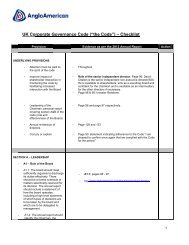Creating Value with the Future in Mind - Anglo American South Africa
Creating Value with the Future in Mind - Anglo American South Africa
Creating Value with the Future in Mind - Anglo American South Africa
You also want an ePaper? Increase the reach of your titles
YUMPU automatically turns print PDFs into web optimized ePapers that Google loves.
manag<strong>in</strong>g our impact on <strong>the</strong> environment water<br />
Our performance<br />
At our operations we use a<br />
comb<strong>in</strong>ation of technology,<br />
behavioural and process change<br />
<strong>in</strong>itiatives aimed at reduc<strong>in</strong>g our total<br />
water consumption and m<strong>in</strong>imis<strong>in</strong>g<br />
any negative impacts on water quality.<br />
Total water use<br />
Despite acquisitions, expansions and<br />
production <strong>in</strong>creases, and tak<strong>in</strong>g <strong>in</strong>to<br />
account divestments, <strong>the</strong> Group has<br />
ma<strong>in</strong>ta<strong>in</strong>ed a reasonably stable level<br />
of water demand s<strong>in</strong>ce 2008.<br />
Dur<strong>in</strong>g 2012, our operations<br />
consumed a total of 139.2 million m 3<br />
of water, of which 122.3 million m 3 was<br />
for primary process and production<br />
activities (2011: 115.3 million m 3 ). The<br />
year-on-year <strong>in</strong>crease was primarily<br />
attributable to greater consumption at<br />
our Los Bronces copper m<strong>in</strong>e <strong>in</strong> Chile<br />
and our Barro Alto nickel plant <strong>in</strong> Brazil.<br />
These <strong>in</strong>creases were mitigated<br />
by: a reduction <strong>in</strong> water use at our<br />
Plat<strong>in</strong>um bus<strong>in</strong>ess, where m<strong>in</strong><strong>in</strong>g<br />
and process<strong>in</strong>g activities were<br />
suspended for several weeks ow<strong>in</strong>g<br />
to unprotected <strong>in</strong>dustrial action; a<br />
significant <strong>in</strong>crease <strong>in</strong> water recycl<strong>in</strong>g<br />
at Los Bronces; and a number of watersav<strong>in</strong>gs<br />
projects implemented around<br />
<strong>the</strong> Group. Through WETT, we are now<br />
able to report on our water usage<br />
aga<strong>in</strong>st projected demand, and to<br />
Total water abstracted,<br />
by source <strong>in</strong> 2012<br />
%<br />
establish water sav<strong>in</strong>gs result<strong>in</strong>g from<br />
our focus on water efficiency. In 2012,<br />
60 water-sav<strong>in</strong>g projects achieved a<br />
sav<strong>in</strong>g of 6.8% aga<strong>in</strong>st our projected<br />
water usage. This <strong>in</strong>cluded a<br />
$66 million <strong>in</strong>vestment <strong>in</strong> projects<br />
specifically designed to save water.<br />
Although <strong>the</strong> direct f<strong>in</strong>ancial sav<strong>in</strong>g<br />
associated <strong>with</strong> this was relatively low,<br />
given that water pric<strong>in</strong>g does not<br />
currently reflect its wider value, our<br />
bus<strong>in</strong>ess case is a broader one that is<br />
often based on o<strong>the</strong>r considerations,<br />
such as pollution control and<br />
community benefit.<br />
In addition to target<strong>in</strong>g overall water<br />
reductions, our operations aim to<br />
re-use and recycle as much water<br />
as possible. In 2012, 72% of our<br />
operational water requirements<br />
were met by recycl<strong>in</strong>g/re-us<strong>in</strong>g water<br />
(2011: 67%). There were several high<br />
performers <strong>in</strong> terms of recycl<strong>in</strong>g, <strong>with</strong><br />
some operations reach<strong>in</strong>g levels as<br />
high as 90% and 97%.<br />
Our operations are also seek<strong>in</strong>g to<br />
reduce <strong>the</strong>ir dependency on highquality<br />
water by switch<strong>in</strong>g to <strong>the</strong> use<br />
of lower-water-quality grades where<br />
this is deemed fit for <strong>the</strong> <strong>in</strong>tended<br />
use. Currently, potable water accounts<br />
for only 18% of our total water<br />
requirements.<br />
Total water required,<br />
by use <strong>in</strong> 2012<br />
%<br />
In 2012, 60<br />
water-sav<strong>in</strong>g<br />
projects<br />
achieved a<br />
sav<strong>in</strong>g of 6.8%<br />
aga<strong>in</strong>st our<br />
projected water<br />
usage. This<br />
<strong>in</strong>cluded a<br />
$66 million<br />
<strong>in</strong>vestment<br />
<strong>in</strong> projects<br />
specifically<br />
designed to<br />
save water.<br />
Water sources affected<br />
by <strong>with</strong>drawal<br />
Our Iron Ore Brazil, Metallurgical Coal,<br />
Thermal Coal, Nickel and Plat<strong>in</strong>um<br />
bus<strong>in</strong>ess units reported no adverse<br />
impacts on local water sources aris<strong>in</strong>g<br />
from <strong>the</strong>ir operations <strong>with</strong>draw<strong>in</strong>g<br />
water. In <strong>South</strong> <strong>Africa</strong>, Kumba’s Sishen<br />
iron ore m<strong>in</strong>e cont<strong>in</strong>ues to manage<br />
issues of concern among local farmers<br />
regard<strong>in</strong>g m<strong>in</strong>e dewater<strong>in</strong>g activities<br />
that impact on <strong>the</strong> availability of<br />
groundwater. Although m<strong>in</strong>e<br />
dewater<strong>in</strong>g draws on water resources<br />
from <strong>the</strong> properties of certa<strong>in</strong><br />
landowners, <strong>the</strong> m<strong>in</strong>e supplies<br />
affected landowners <strong>with</strong> alternative<br />
sources of water as and when required.<br />
Dewater<strong>in</strong>g activities at Kumba’s<br />
Kolomela m<strong>in</strong>e are managed <strong>in</strong> a<br />
similar manner, and good relations<br />
have been established <strong>with</strong><br />
landowners. Opportunities to use<br />
<strong>in</strong>novative approaches to <strong>the</strong>se issues,<br />
such as aquifer grout<strong>in</strong>g and water<br />
re-<strong>in</strong>jection <strong>in</strong>to aquifers, are be<strong>in</strong>g<br />
<strong>in</strong>vestigated as possible future<br />
mitigation measures.<br />
Copper’s Mantoverde m<strong>in</strong>e <strong>in</strong> Chile<br />
is situated <strong>in</strong> one of <strong>the</strong> driest regions<br />
of <strong>the</strong> world and is dependent on <strong>the</strong><br />
already-stressed Copiapó aquifer for<br />
its water. We are build<strong>in</strong>g a desal<strong>in</strong>ation<br />
plant that will meet <strong>the</strong> plant’s water<br />
needs, <strong>the</strong>reby alleviat<strong>in</strong>g pressure<br />
on <strong>the</strong> Copiapó aquifer from 2014. To<br />
assist <strong>the</strong> local community, we have<br />
also negotiated <strong>with</strong> local water service<br />
providers to provide access to wells<br />
<strong>the</strong> m<strong>in</strong>e no longer uses.<br />
Water quality<br />
M<strong>in</strong><strong>in</strong>g <strong>in</strong>fluences both <strong>the</strong> amount<br />
of water that is available, and its<br />
chemistry. Poor-quality water is not<br />
only harmful to <strong>the</strong> environment and<br />
human health, but it is also detrimental<br />
to m<strong>in</strong><strong>in</strong>g operations as it can be<br />
destructive to equipment. The volume<br />
and quality of water that is allowed to<br />
be discharged by our operations are<br />
pre-determ<strong>in</strong>ed through regulatory<br />
processes. Any unplanned discharges<br />
or breaches of legal agreements are<br />
reported as environmental <strong>in</strong>cidents<br />
and addressed promptly.<br />
We employ a five-tiered scale to report<br />
on <strong>the</strong> impact of an <strong>in</strong>cident. Level 1<br />
and 2 <strong>in</strong>cidents are m<strong>in</strong>or <strong>in</strong> nature<br />
and, while remedial action is taken for<br />
every <strong>in</strong>cident, <strong>the</strong>y are not reported<br />
Ground water 34<br />
Surface water 31<br />
Potable water from an<br />
external source 18<br />
Waste water/second-class water 9<br />
Non-potable water from an<br />
external source 8<br />
Water re-used/recycled<br />
<strong>in</strong> processes 72<br />
Water used for<br />
primary activities 25<br />
Water used for<br />
non-primary activities 3<br />
58 <strong>Anglo</strong> <strong>American</strong> plc Susta<strong>in</strong>able Development Report 2012



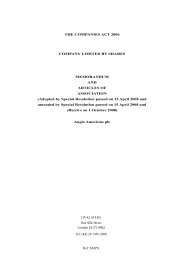
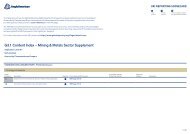
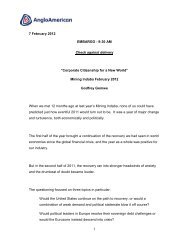
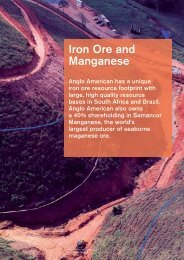
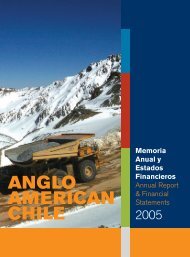
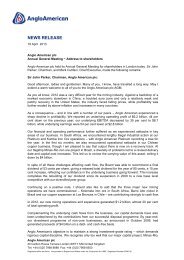
![English PDF [ 189KB ] - Anglo American](https://img.yumpu.com/50470814/1/184x260/english-pdf-189kb-anglo-american.jpg?quality=85)
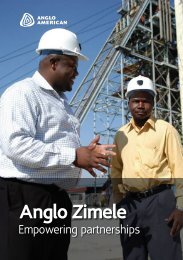

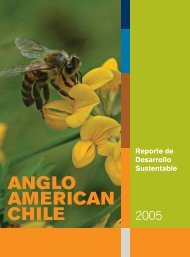

![pdf [ 595KB ] - Anglo American](https://img.yumpu.com/49420483/1/184x260/pdf-595kb-anglo-american.jpg?quality=85)
![pdf [ 1.1MB ] - Anglo American](https://img.yumpu.com/49057963/1/190x240/pdf-11mb-anglo-american.jpg?quality=85)
